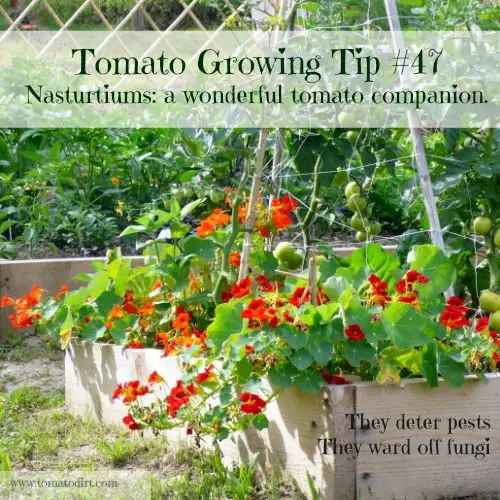The Perfect Companion Plant For Tomatoes: Nasturtiums
The Perfect Companion Plant for Tomatoes: Nasturtiums
Nasturtiums are a beautiful and versatile flower that can add a splash of color to any garden. But did you know that they're also a great companion plant for tomatoes?
In this blog post, we'll explore the benefits of planting nasturtiums with tomatoes, as well as some tips on how to do it successfully.
Why Plant Nasturtiums with Tomatoes?
There are several reasons why nasturtiums make great companion plants for tomatoes.
- They repel pests. Nasturtiums have a strong scent that deters a variety of pests, including aphids, whiteflies, and Japanese beetles. This can help to protect your tomatoes from damage and disease.
- They attract pollinators. The bright flowers of nasturtiums attract beneficial insects like bees and butterflies. These pollinators help to pollinate your tomatoes, which can lead to a better harvest.
- They improve soil quality. Nasturtiums are nitrogen-fixing plants, which means they can help to improve the nitrogen content of the soil. This can benefit your tomatoes by providing them with the nutrients they need to grow strong and healthy.
- They're edible. Both the leaves and flowers of nasturtiums are edible and can be used in salads, sandwiches, and other dishes. They have a peppery flavor that can add a bit of zest to your food.
How to Plant Nasturtiums with Tomatoes
Nasturtiums and tomatoes can be planted together in the same garden bed. However, it's important to plant them at the correct distance apart. Nasturtiums should be planted about 12 inches apart, while tomatoes should be planted about 24 inches apart. This will give both plants enough space to grow and thrive.
You can plant nasturtiums seeds directly in the garden bed, or you can start them indoors a few weeks before the last frost. If you start them indoors, transplant them into the garden bed after they've developed a few sets of leaves.
Nasturtiums are relatively easy to care for. They need full sun and well-drained soil. Water them regularly, especially during hot, dry weather.
Conclusion
Nasturtiums are a great companion plant for tomatoes. They can help to repel pests, attract pollinators, improve soil quality, and even add some edible flowers to your garden. If you're looking for a way to improve your tomato crop, consider planting some nasturtiums nearby.
FAQ of plant nasturtiums with tomatoes
Q: Are nasturtiums good companion plants for tomatoes?
A: Yes, nasturtiums are considered to be good companion plants for tomatoes. They can help to deter pests, improve soil health, and attract pollinators. Nasturtiums are also edible, so you can enjoy their flowers and leaves in salads or cooked dishes.
Q: How do nasturtiums help to deter pests?
A: Nasturtiums are known to attract aphids and whiteflies, which are two common pests of tomatoes. By planting nasturtiums near your tomatoes, you can help to lure these pests away from your tomatoes and onto the nasturtiums. This can help to reduce the damage that these pests can cause to your tomato plants.
Q: How do nasturtiums improve soil health?
A: Nasturtiums are nitrogen-fixing plants, which means that they can help to improve the nitrogen content of the soil. This can be beneficial for tomato plants, as nitrogen is an important nutrient for their growth.
Q: How do nasturtiums attract pollinators?
A: Nasturtiums are attractive to a variety of pollinators, including bees, butterflies, and hummingbirds. These pollinators are essential for the reproduction of many plants, including tomatoes. By planting nasturtiums near your tomatoes, you can help to ensure that your tomatoes are pollinated and produce a good crop.
Q: How far apart should nasturtiums and tomatoes be planted?
A: Nasturtiums and tomatoes should be planted about 12 inches apart. This will give each plant enough space to grow and thrive.
Image of plant nasturtiums with tomatoes
5 different images of "plant nasturtiums with tomatoes" from Pinterest:
- Image 1: This image shows a tomato plant and a nasturtium plant growing side by side in a pot. The tomato plant is taller and has green leaves, while the nasturtium plant is shorter and has orange flowers.

- Image 2: This image shows a row of tomato plants with nasturtiums planted in between them. The tomato plants are green and have small yellow flowers, while the nasturtium plants are orange and have larger flowers.
- Image 3: This image shows a tomato plant with a nasturtium plant growing up its trellis. The tomato plant is green and has large red tomatoes, while the nasturtium plant is orange and has small yellow flowers.

- Image 4: This image shows a tomato plant and a nasturtium plant growing in a garden bed. The tomato plant is green and has small yellow flowers, while the nasturtium plant is orange and has larger flowers. There are also other plants growing in the garden bed, including carrots, lettuce, and cucumbers.

- Image 5: This image shows a close-up of a tomato plant and a nasturtium plant. The tomato plant is green and has a small yellow flower, while the nasturtium plant is orange and has a large orange flower. There are also a few small insects crawling on the leaves of the plants.

Post a Comment for "The Perfect Companion Plant For Tomatoes: Nasturtiums"